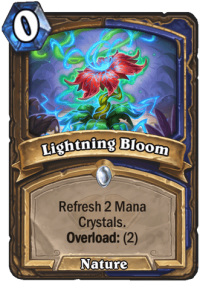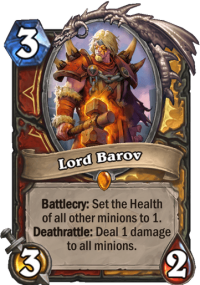The just-released mini-set features the return of one of the most popular mechanics in recent Hearthstone history: the flavorful and exciting dual-class cards. But how did these cards come to be, how do the new ones compare with their predecessors, and what can we expect from them going forward? Read on for… well, perhaps not ironclad answers, but definitely relevant musings!
A Trip Down Memory Lane
You might be thinking the story of dual-class cards began with Scholomance Academy, but we need to go back all the way to 2016 to find cards shared across multiple classes in the form of the Mean Streets of Gadgetzan expansion’s tri-class cards.

Back then, the nine original classes were grouped into three criminal gangs. Hunters, Warriors and Paladins joined the Grimy Goons, a handbuff-based crew that were dead on arrival, gunned down in a back alley in brutal fashion before they could even formulate a plan. The Pirate package, featuring Patches the Pirate (who originally had Charrrrrge), was superior for aggressive decks, especially because the cards in question were too conservatively statted – especially something like Grimestreet Informant, whose 2 mana 1/1 statline looks ludicrous today.
Druids, Rogues and Shamans shared the Jade package, and while Valeera could never really make a good use of it, saddled with Deathrattles instead of Battlecries, both Malfurion and Thrall could build decks around summoning larger and larger men – especially the former, with the infamous Jade Idol, Hearthstone’s first and longest-standing infinite stat-vomitorium. Speaking of woeful statlines, take a look at Lotus Agents and weep!

Finally, Mages, Priests and Warlocks got the Kazakus package, with Potions and a highlander requirement. I still fondly remember playing qualifier tournaments with a triple-Reno lineup, which, incidentally featured its own rock-paper-scissors element: Reno Warlock crushed Reno Priest (this was in the pre-Razakus days), Reno Priest drowned Reno Mages in a sea of value, and Reno Mages burned down Reno Warlock players, full heal notwithstanding.
If you squint hard enough, you can see the flavor associated with the gangs. The raw aggression and ogre-like dumminess of the weapons classes. The Nature and, erm, I guess, stealth element of the Jades shared across Druid, Shaman and Rogue. The three spell-oriented classes getting the Kazakus stuff.
You can see how there are vague outlines of synergies, but it was more about pairing the gangs as a core concept with representative classes rather than designing cards specifically for cross-class purposes. In many ways, they were a useful predecessor of what was to come – and arguably the first significant increase in power level across a whole set.
Scholastic Struggles

Dual-class cards were originally introduced in the Scholomance Academy expansion, and they were universally well-received by the community. Combining great flavor and opening up unique gameplay opportunities, they were a much more tightly designed package than the tri-class cards of the past, with effects tied much more closely to the classes involved. With forty such cards (four for each pairing) instead of the nine total tri-class cards, they had a much larger impact on the metagame.
These cards served to expand the possibility space for the classes involved (like giving Shamans mana cheat options with Lightning Bloom and an Equality-like effect for Warriors, a class positively predisposed to Whirlwind-like effects, with Lord Barov), in a way where the cards made sense for both classes involved but would have looked odd and unfitting without the specific presence of the other class’ colors. Powerful, relevant, but rarely obnoxious, it was one of the clear cases where Team 5 knocked it out of the park.

That isn’t to say dual-class cards don’t come with an ugly underbelly. With the added presence of Demon Hunters, the set marked another step on the road away from the time when a large and relevant foundation of Neutral cards formed the backbone of a release, allowing players to rely on them to create viable decks across multiple classes. The presence of neutral cards served as a significant differentiator between Hearthstone and a game like Magic: the Gathering, but the game’s been moving more towards the MTG-like approach of exclusive and cross-class cards, for better or for worse.
A Musical Future
So how do the Audiopocalypse dual-class cards compare to the original? Though we still have to wait for a little while to figure out whether they will be anywhere near as effective as their Scholomance counterparts, we can already make a few important observations.
First, the theming is nowhere near as clean as it was with their predecessors. A quick look at the Hearthstone wiki gives you straightforward one-word summaries of the themes enabling the dual-class relations, which formed the theming of the pre-release Inn-vitational event:
- Druid & Hunter — Beasts
- Hunter & Demon Hunter — Hunt
- Demon Hunter & Warlock — Fel
- Warlock & Priest — Bones
- Priest & Paladin — Light
- Paladin & Warrior — Honor
- Warrior & Rogue — Blades
- Rogue & Mage — Tricks
- Mage & Shaman — Elements
- Shaman & Druid — Nature
There’s nothing similar to lean on this time around (all the announcement post has to say about dual-class cards is “explore genre-bending sounds”), and the class pairings feel a bit odder and less intuitive.

Druid and Priest share… tokens and mana refreshment? Warriors get an Evolve thing because… Taunt? Paladins get a Totem, because token? Tough Crowd, a card that’s as Rouge-y as it gets, is shared with Demon Hunter because of a tribal tag and a keyword that actively lowers its power level (let’s be honest, it should just be a Battlecry card)? It’s a more exotic, braver design, but clearly a worse thematic fit, with Shamans especially sticking out like a sore thumb.
Of course, since it was only a mini-set and not a full expansion, devs had a lot less room to explore those themes. Scholomance came with 4 cards per class pairing, while Audiopocalypse only released 2. Scholomance also already explored many fitting pairings, so if Blizzard wanted to do something fresh, they had to reach for less obvious ones.

It only goes to show how difficult it is to design these cards in an effective fashion, and why they haven’t become a mainstay in the game yet. Functionally, many of Hearthstone’s playable neutrals were dual-class or tri-class cards – no one would play Secretkeeper in a Priest deck – but marrying two classes in this fashion gives you a very specifically shaped design space that isn’t always fillable in a satisfying way.
As you can probably guess, I’m not as happy with the Audiopocalypse dual-class cards as the Scholomance ones (thematically, because it’s a bit too early to judge them from the gameplay perspective yet). I believe that dual-class cards will be explored in the future, but you probably shouldn’t expect them to release in every expansion. I just hope they pump up the pairing flavor a bit more next time around.

Theme-wise, there’s a good few cards from Audiopocalypse that do fit the mechanics and musical genres of mixing the classes together. Yelling Yodeler took me a while, but it’s one of the cards I feel exemplifies this best: yodeling is a major form of European folk music and heavy metal features a lot of death growls and screams – though we don’t really have much in the way of Deathrattle synergies for Hunter, do we? Funnel Cake seems to be based on how Priest seems to have more board presence focus with Overheal synergies – and we do still have Priestess Valishj in the format.
Sure, it’s not visibly obvious for every class combination, and I’ll agree the execution doesn’t feel as clean as Scholomance’s was, but it’s there.